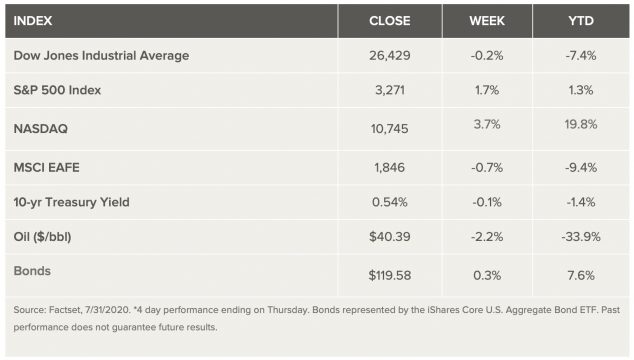Stock Markets
GDP growth data was released last week, showing the sharpest quarterly downturn on record, driven by shutdown policies aimed at combatting the spread of the coronavirus. The negative GDP growth, however, was better than expected, with stocks finishing the week slightly higher on positive earnings news. Big tech held the earnings spotlight, with three big tech names (Facebook, Amazon, and Apple) reporting results that were significantly better than expected. Congressional negotiations over a fifth coronavirus relief bill were stalled as Democrats and Republicans struggle to reach terms.
US Economy
Stocks escaped a busy week of earnings, economic data reports, and the Federal Reserve’s (Fed) policy meeting unscathed, finishing modestly higher and adding to the biggest four-month gain in the S&P 500 since 2009. At the same time, nervousness about the negotiations over the next round of fiscal relief, along with concerns about the sustainability of the rebound, pushed the 10-year yield to its third-lowest closing level on record and the five-year yield to a new record low.
Nevertheless, a fresh look at the three underpinnings of long-term investment returns – the economy, earnings, and monetary policy – reveals that the fundamental backdrop, while fragile, is trending in the right direction, according to analysts. A rebound in economic activity and corporate earnings, along with ongoing monetary-policy stimulus, should provide broad support, but virus concerns and political uncertainties are likely to spark bouts of volatility along the way.
Metals and Mining
Gold continued to trend higher this week breaking its previous all-time high. A weak US dollar and a steady uptick in America’s new COVID-19 cases sent investors to safe havens, ultimately benefiting gold and silver. Poor economic data is painting a bleak picture for economic recovery as many analysts begin to realize the rumored V-shaped recovery will not materialize. The yellow metal started the session firmly planted above US$1,900 per ounce. By mid-week the metal had reached US$1,970 and was still strengthening. Silver also performed positively this week, reaching price territory unseen since 2013. The white metal moved from its Monday start price of US$24.10 per ounce to a seven-year high of US$25.89, prompting many to speculate how high the metal will go. As industrial demand has shrunk, exchange traded fund demand has helped the metal add to its value during the first half of 2020. Platinum faced some challenges this session, which weighed on its ability to lock in gains. A brief mid-week rally saw the price top US$951 per ounce. However, the price faced pressure from declining consumer demand in the auto sector and pulled back. The palladium story was similar this week, as the weakened auto sector continues to grapple with a host of transport and logistical issues. A mid-week high of US$2,2267 per ounce brought the metal back to pre-pandemic levels. The rally then reversed as the price fell below US$2,000. Despite weak economic information from America, copper was able to hold above US$6,400 per tonne this session. The price has continued to strengthen over the last three months thanks to improved demand from China.
Zinc edged higher this week to a six-month despite surplus levels rising at the London Metals Exchange warehouse. The stockpile may weigh on prices later in the quarter, however for now investors continue to believe in the sector. Zinc was valued at US$2,275 per tonne on Friday. Nickel prices continue to fell pressure. A 1.8 percent price slip mid-week brought the metal to US$13,470 per tonne. Lead made some minor gains over the five-day period. Despite edging higher lead is still 18.7 percent off its year-to-date high of US$2,265 per tonne and expected to face continued headwinds from the demand side.
Energy and Oil
Oil prices retreated on Thursday after the U.S. posted a horrific second quarter GDP figure. Prices steadied in early trading on Friday, pushing crude benchmarks back to familiar territory – roughly $40 for WTI and $43 for Brent. ExxonMobil reported a loss of nearly $1.1 billion, the largest quarterly loss in 36 years. Production was down 7 percent, year-on-year. Exxon said its working on cost-cutting plans in a “last ditch” effort to preserve its dividend. and CEO Darren Woods said that the company would not take on more debt. Chevron reported an adjusted loss of $3 billion, along with an impairment of $5.6 billion. That included writing off Chevron’s entire unit in Venezuela, worth about $2.6 billion. “We would need to see sustained economic recovery and much lower inventory levels before we would add capital back to the Permian or other basins,” Pierre Breber, Chevron’s finance chief, told the media. “We’re in a lower for longer world where demand is down and there’s ample supply.” Across the border, Canada is on track to drill 2,800 wells this year, according to the Petroleum Services Association, the third downward revision for the group. Last year, the industry drilled 4,900 wells. Natural gas spot prices rose at most locations this week. The Henry Hub spot price rose from a low of $1.64 per million British thermal units (MMBtu) last week to $1.75/MMBtu this week. At the New York Mercantile Exchange (Nymex), the August 2020 contract expired Thursday at $1.854/MMBtu, up 17¢/MMBtu from last week. The September 2020 contract price increased to $1.930/MMBtu, up 21¢/MMBtu from last week to this week. The price of the 12-month strip averaging September 2020 through August 2021 futures contracts climbed 18¢/MMBtu to $2.620/MMBtu.
World Markets
Equities in Europe fell on concerns about an economic recovery due to a resurgence in coronavirus infections, U.S.-China tensions, and disappointing company earnings. In local currency terms, the pan-European STOXX Europe 600 Index ended the week about 3.0% lower, Germany’s DAX Index fell 4.1%, and France’s CAC 40 slid 3.5%. The UK’s FTSE 100 Index dropped 3.7%.
European corporate earnings were generally downbeat in the second quarter, especially for banks. In energy, Royal Dutch Shell and Total proved resilient as strong oil trading revenues helped offset falling energy demand triggered by the pandemic. In autos, results from Volkswagen and Renault disappointed.
The German and French economies slumped in the second quarter as household spending, business investment, and exports collapsed during the coronavirus pandemic, according to preliminary data. Germany’s GDP shrank by a record 10.1% quarter on quarter, and in France, where restrictions were stricter, the economy contracted 13.8%.
In China, mainland equity markets rallied on positive data despite elevated U.S.-China tensions and floods in the country’s Yangtze River basin. The large-cap CSI 300 Index rose 4.2%, and the benchmark Shanghai Composite Index gained 3.5%, reversing the previous week’s declines. A-share funds suffered outflows during the week after a correction the previous Friday, with institutional outflows outweighing retail investor inflows. Northbound Stock Connect (investments in mainland stocks by Hong Kong-based foreign investors) saw significant net outflows, especially in financial stocks.
The Week Ahead
Important data being released next week include construction spending, the unemployment rate, the Purchasing Managers’ Index (PMI) composite, and consumer credit.
Key Topics to Watch
- Markit manufacturing PMI
- ISM manufacturing index
- Construction spending
- Motor vehicle sales
- Factory orders June
- ADP employment report
- Trade deficit
- Treasury quarterly refunding
- Markit services PMI
- ISM nonmanufacturing index July
- Initial jobless claims (state program, SA)
- Initial jobless claims (total, NSA)
- Continuing jobless claims (state program, SA)
- Continuing jobless claims (total, NSA)
- Household debt (SAAR)
- Nonfarm payrolls
- Unemployment rate
- Average hourly earnings
- Wholesale inventories
- Consumer credit
Markets Index Wrap Up


